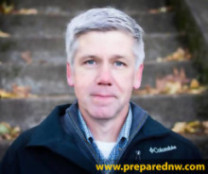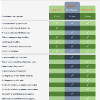
Getting Lake Oswego ready to rumble

REVIEW PHOTO: VERN UYETAKE
Is Lake Oswego prepared for the aftermath of a major earthquake or other natural disaster? Larry Goff of the Lake Oswego Fire Department and neighborhood association leaders Cheryl Uchida (from left), Jan Castle and Jim Newcomer are making sure plans are in place.
“Everything west of Interstate 5 will be toast.”That’s what a federal emergency management official told author Kathryn Schulz for her article in The New Yorker last month about “The Really Big One,” sending shockwaves across the Pacific Northwest.
More than 13,000 people will die when the Cascadia Subduction Zone shifts, the article said, and another 2,500 will be injured in the devastating earthquake and tsunami that follow. Experts say it could take months to restore water, sewer, electricity and natural gas. Longer to repair the infrastructure — roads, bridges, rail lines — that will serve as a lifeline for desperately needed equipment, food and supplies.
The chances of that happening within the next 50 years, experts told Schulz, is one in 10 — a prediction that caused aftershocks not only of concern and fear but also of increased awareness.
And that, Larry Goff says, is a good thing.
“All of the information was out there before,” says Goff, the operations chief and emergency preparedness director for the Lake Oswego Fire Department. “But this article hit a chord with a lot of people. And I’ll take that.”
Even Goff’s sister in Olympia made the head-smacking admission that, “I never heard about this!”
“It went viral,” says Jan Castle, chairwoman of the McVey/South Shore Neighborhood Association and one of the founders of the Lake Oswego Sustainability Network. The organization partnered with the city in May to sponsor a seminar called “Surviving a 9.0.”
“The goal,” Castle says, “was to inspire individual citizens to do their own preparation for their own homes.”
That’s been Goff’s message for decades.

REVIEW PHOTO: VERN UYETAKE
Cheryl Uchida (left) and Jan Castle are working to educate members of their Lake Oswego neighborhood associations about what to have on hand when a natural disaster strikes.
Since 1995, he’s helped to lead Community Emergency Response Team (CERT) classes that have prepared more than 1,500 Lake Oswegans to take care of themselves and their families in the wake of a natural disaster. And he has worked closely with the city’s neighborhood associations to make sure the community is ready.
“I’m feeling really encouraged by our progress, even though there is a long way to go,” Goff says. “I feel good when I see Jan, Rick, Cheryl and Jim doing things to prepare their neighborhoods.”
He’s talking about McVey/South Shore’s Jan Castle, Cheryl Uchida and Jim Newcomer of the Waluga Neighborhood Association and Rick Eilers of the Palisades Neighborhood Association, who all play key roles in the city’s disaster preparations.
In fact, Uchida is called “the queen of Lake Oswego preparedness” by Castle. She and Newcomer have been working for four years to make Waluga the prototype for neighborhood preparedness in Lake Oswego.
“We now have a comprehensive, carefully thought out plan to engage our neighborhood residents,” Uchida says. “We have the potential (for reaching) well over 700 dwelling units in our area, including high-density residential complexes.”
Castle, who completed CERT training in June, started the emergency preparedness plan for her neighborhood association last September. She was inspired, she says, after listening to Althea Rizzo, the geologic hazards program coordinator for Oregon Emergency Management. Rizzo painted a striking picture of what would happen after a Cascadia Subduction Zone quake.
“After Althea trained me, I developed my own talk,” Castle says. “I gave my talk to 10 or 12 houses at a time. I wanted people to get used to the idea of working together, because in all emergencies, people who do the best are the ones who work with their neighborhoods.”
For Eilers, inspiration came in the wake of the devastating March 2011 earthquake in Japan, which claimed just under 16,000 lives. Eilers volunteered to organize an emergency preparedness committee for the Palisades Neighborhood Association, and two years ago started a business called Prepared Northwest Inc. The company’s goal: to help families prepare for earthquakes by making plans, gathering supplies and learning to utilize their time and money most effectively.
“I’ll ride out the shaking, just as everyone else will,” Eilers says. “I’ll check my watch when the shaking starts and try to determine how long the event lasts. It will give me an idea how strong the quake was and what type of local or regional damage to expect.”
Eilers tells his neighbors to first make sure their own family is safe, check out their house next and then try to help others. Uchida agrees.
“We have to take care of ourselves first, our family second and finally our immediate neighbors,” she says. She advises having on hand a hard hat, sturdy shoes, gloves, headlamp and safety glasses.
Newcomer most stresses the need for sturdy shoes, because “there is so much broken glass after earthquakes. Feet can get cut so easily.”
Goff says the thought of dealing with the aftermath of an earthquake can seem overwhelming. “But you’ve got to start taking steps to prepare and continue to do steps,” he says. “There is reassurance when you are prepared.”
One good place to start is the LOFD’s B Avenue fire station, where residents can pick up a copy of the “Map Your Neighborhood” brochure. It lists nine steps to take as soon as possible after an earthquake, including taking care of your loved ones; protecting your heads, hands and feet; checking the natural gas or propane connections in your home; shutting off water at the house main; putting a fire extinguisher on your sidewalk; going to your neighborhood association gathering site to assign action teams; and seeking out homes which display the “Help” card in order to give assistance.
Among the questions residents should be asking now, Goff says:
n Is your home bolted to the foundation and your water heater strapped down? Do you know the location of utility shutoffs and have the necessary tools nearby?
n Do your family and friends know where to gather after an earthquake and how to get there? If roads and bridges are out, can everyone get from work or school to the reconnection spot?
n Do you have a disaster supply kit ready? Experts say you should have anywhere from three days to two weeks of food and water on hand, along with a backpack filled with tools, medical supplies, flashlights and batteries, walkie-talkies or a hand-cranked radio, and other equipment. (The American Red Cross has a pretty good list of the supplies you’ll need at redcross.org/prepare/location/home-family/get-kit.)
n Perhaps most importantly, do you know your neighbors? Have you talked about the need to prepare as a group, to know who has medical training or other skills crucial to surviving until first responders arrive?
It’s that last point, of course, that resonates the most with Newcomer and the other neighborhood association leaders.
“The effort really must come from the neighborhoods,” he says. “People won’t accept preparedness plans if they’re imposed by the government. We hope to prepare a picture for the City Council that will convince them this is something they should support in an ongoing way.”
Uchida also hopes the city will soon buy in to the importance of a phased and ongoing plan and provide public funds for the process.
“This planning should never stop,” Uchida says. “This is a sustainable program that builds a resilient neighborhood and nurtures a sense of community — characteristics that the City of Lake Oswego desires.”
In the meantime, Castle says, neighborhood associations will continue their work to make sure Lake Oswego is as well prepared for an earthquake as possible.
“Let’s do it. Let’s get started. We want to lay a foundation where people will want to build awareness into their culture,” she says. “People will be prepared because of what they’re doing today.”
Residents can check their neighborhood association websites to see how well emergency preparations are going (waluganeighborhood.org is one). More information about earthquake and emergency preparation is also available at preporegon.org and on the city’s website at www.ci.oswego.or.us/citymanager/emergency-management-program.
Contact Cliff Newell at 503-636-1281 ext. 105 or cnewell@lakeoswegoreview.com.



